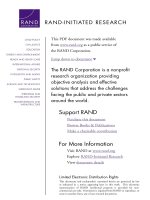Access Control Models: From the real-world to trusted computing potx
Bạn đang xem bản rút gọn của tài liệu. Xem và tải ngay bản đầy đủ của tài liệu tại đây (254.88 KB, 35 trang )
Access Control Models: From the
Access Control Models: From the
real-world to trusted computing
real-world to trusted computing
Lecture Motivation
Lecture Motivation
We have looked at protocols for distributing and establishing keys used for
authentication and confidentiality
But who should you give these keys to? Who should you trust? What are the
rules governing when to and not to give out security credentials
In this lecture, we will look at the broad area of secure and trusted systems
–
We will focus on access control models
–
These methods are often used to abstract the requirements for a
computer system
–
But, they hold for general systems where security is a concern (e.g.
networks, computers, companies…)
Lecture Outline
Lecture Outline
Some generic discussion about security
Objects that require protection
Insights from the real-world
Access control to memory and generic objects
–
Discretionary Methods: Directory Lists, Access Control
Lists, and the Access Control Matrix, Take-Grant Model
–
Failures of DACs: Trojan Horses
–
Dominance and information flow, Multilevel security and
lattices
–
Bell-LaPadula and Biba’s Model
What is a trusted system? Trusted Computing Base
System-security vs. Message-security
System-security vs. Message-security
In the cryptographic formulation of security, we were concerned with the
confidentiality, authenticity, integrity, and non-repudiation of messages
being exchanged
–
This is a message-level view of security
A system-level view of security has slightly different issues that need to be
considered
–
Confidentiality: Concealment of information or resources from those
without the right or privilege to observe this information
–
Integrity: Trustworthiness of data (has an object been changed in an
unauthorized manner?)
–
Availability: Is the system and its resources available for usage?
Confidentiality in Systems
Confidentiality in Systems
Many of the motivations behind confidentiality comes from the military’s
notion of restricting access to information based on clearance levels and
need-to-know
Cryptography supports confidentiality: The scrambling of data makes it
incomprehensible.
–
Cryptographic keys control access to the data, but the keys themselves
become an object that must be protected
System-dependent mechanisms can prevent processes from illicitly
accessing information
–
Example: Owner, group, and public concepts in Unix’s r/w/x definition
of access control
Resource-hiding:
–
Often revealing what the configuration of a system is (e.g. use of a
Windows web server), is a desirable form of confidentiality
Integrity in Systems
Integrity in Systems
Integrity includes:
–
Data integrity (is the content unmodified?)
–
Origin integrity (is the source of the data really what is claimed, aka.
Authentication)
Two classes of integrity mechanisms: Prevention and Detection
Prevention: Seek to block unauthorized attempts to change the data, or
attempts to change data in unauthorized ways
–
A user should not be able to change data he is not authorized to change
–
A user with privileges to work with or alter the data should not be
allowed to change data in ways not authorized by the system
–
The first type is addressed through authentication and access control
–
The second type is much harder and requires policies
Detection: Seek to report that data’s integrity has been violated
–
Achieved by analyzing the system’s events (system logs), or analyze
data to see if required constraints are violated
Availability of Systems
Availability of Systems
Availability is concerned with system reliability
–
The security side of the issue: An adversary may try to make a resource
or service unavailable
–
Implications often take the form: Eve compromises a secondary system
and then denies service to the primary system… as a result all requests of
the first system get redirected to second system
–
Hence, when used in concert with other methods, the effects can be very
devastating
Denial of service attacks are an example:
–
Preventing the server from having the resources needed to perform its
function
–
Prevent the destination from receiving messages
–
Denial of service is not necessary deliberate
Threats
Threats
There are several threats that may seek to undermine confidentiality,
integrity, and availability:
–
Disclosure Threats: Causing unauthorized access to information
–
Deception Threats: Causing acceptance of false data
–
Disruption Threats: Prevention of correct operation of a service
–
Usurpation Threats: Unauthorized control of some service
Examples:
–
Snooping: Unauthorized interception of information (passive Disclosure)
–
Modification/Alteration: Unauthorized change of information (active
Deception, Disruption, Usurpation)
–
Masquerading/Spoofing: Impersonation of one entity by another
(Deception and Disruption)
–
Repudiation of Origin: False denial that an entity sent or created data
(Deception)
–
Denial of Receipt: A false denial that an entity received some information
or message (Deception)
–
Delay: A temporary delay in the delivery of a service (Usurpation)
–
Denial of Service: A long-term inhibition of service (Usurpation)
Overview Security Policies
Overview Security Policies
Definition: A security policy is a statement of what is allowed and what is
not allowed to occur between entities in a system
Definition: A security mechanism is a method for enforcing a security
policy
Policies may be expressed mathematically
–
Allowed and disallowed states may be specified
–
Rules may be formulated for which entity is allowed to do which action
These policies may seek to accomplish:
–
Prevention
–
Detection
–
Recovery
This lecture will focus primarily on formal statements of security policies
–
Specifically, we will focus on policies associated with access control and
information flow
Objects that Need Protection
Objects that Need Protection
Modern operating systems follow a multiprogramming model:
–
Resources on a single computer system (extend this to a generic system)
could be shared and accessed by multiple users
–
Key technologies: Scheduling, sharing, parallelism
–
Monitors oversee each process/program’s execution
Challenge of the multiprogramming environment: Now there are more
entities to deal with… hard to keep every process/user happy when sharing
resources… Even harder if one user is malicious
Several objects that need protection:
–
Memory
–
File or data on an auxiliary storage device
–
Executing program in memory
–
Directory of files
–
Hardware Devices
–
Data structures and Tables in operating systems
–
Passwords and user authentication mechanisms
–
Protection mechanisms
Basic Strategies for Protection
Basic Strategies for Protection
There are a few basic mechanisms at work in the operating system that
provide protection:
–
Physical separation: processes use different physical objects (different
printers for different levels of users)
–
Temporal separation: Processes having different security requirements
are executed at different time
–
Logical separation: Operating system constrains a program’s accesses
so that it can’t access objects outside its permitted domain
–
Cryptographic separation: Processes conceal their data in such a way
that they are unintelligible to outside processes
–
Share via access limitation: Operating system determines whether a
user can have access to an object
–
Limit types of use of an object: Operating system determines what
operations a user might perform on an object
When thinking of access to an object, we should consider its granularity:
–
Larger objects are easier to control, but sometimes pieces of large
objects don’t need protection.
–
Maybe break objects into smaller objects (see Landwehr)
Access Control to Memory
Access Control to Memory
Memory access protection is one of the most basic functionalities of a
multiprogramming OS
Memory protection is fairly simple because memory access must go through
certain points in the hardware
–
Fence registers, Base/Bound registers
–
Tagged architectures: Every word of machine memory has one or more
extra bits to identify access rights to that word (these bits are set only by
privileged OS operations)
–
Segmentation: Programs and data are broken into segments. The OS
maintains a table of segment names and their true addresses. The OS
may check each request for memory access when it conducts table
lookup.
More general objects may be accessed from a broader variety of entry points
and there may be many levels of privileges:
–
No central authority!
Insight from Real-world Security Models
Insight from Real-world Security Models
Not all information is equally sensitive– some data will have more drastic
consequences if leaked than other.
–
Military sensitivity levels: unclassified, confidential, secret, top secret
Generally, fewer people knowing a secret makes it easier to control
dissemination of that information
–
Military notion of need-to-know: Classified information should not be
entrusted to an individual unless he has both the clearance level and the
need to know that information
–
Compartments: Breaking information into specific topical areas
(compartments) and using that as a component in deciding access
–
Security levels consist of sensitivity levels and the corresponding
compartments
–
If information is designated to belong to multiple compartments, then the
individual must be cleared for all compartments before he can access the
information.
Real-world Security Models, pg. 2
Real-world Security Models, pg. 2
Documents may be viewed as a collection of sub-objects, some of which are
more sensitive than others.
–
Hence, objects may be multilevel in their security context.
–
Level of classification of an object or document is usually the
classification of its most sensitive information it contains.
Aggregation Problem: Often times the combination of two pieces of data
creates a new object that is more sensitive than either of the pieces separately
Sanitization Problem: Documents may have sensitive information removed
in an effort to sanitize the document. It is a challenge to determine when
enough information has been removed to densensitize a document.
Multilevel Security Models
Multilevel Security Models
We want models that represent a range of sensitivities and that separate
subjects from the objects they should not have access to.
The military has developed various models for securing information
We will look at several models for multilevel security
–
Object-by-Object Methods: Directory lists, Access control lists, Access
control matrix, Take-Grant Model
–
Lattice model: A generalized model
–
Bell-LaPadula Model
–
Biba Model
Access Control to Objects
Access Control to Objects
Some terminology:
–
Protection system: The component of the system architecture whose task
is to protect and enforce security policies
–
Object: An object is an entity that is to be protected (e.g. a file, or a
process)
–
Subject: Set of active objects (such as processes and users) that have
interaction with other
–
Rights: The rules and relationships allowed to exist between subjects and
objects
Directory-based Access Control (aka. Capability List): A list for each subject
which specifies which objects that subject can access (and what rights)
Access Control List: A list for each object that specifies which subjects can
access it (and how).
Access Control Matrix
Access Control Matrix
Access control matrix arose in both OS research and database research
Example:
What does it mean for a process to read/write/execute another process?
–
Read is to receive signals from, write is to send signals to, and execute is
to run as a subprocess
Formally, an access control matrix is a table in which each row represents a
subject and each column represents an object.
–
Each entry in the table specifies the set of access rights for that subject to
that object
–
In general access control matrices are sparse: most subjects do not have
access rights to most objects
–
Every subject is also an object!!!
File1 File2 Process1 Process2
Process1 Read,Write,Own Read
Read,Write,
Execute,Own Write
Process2 Append Read,Own Read
Read,Write,
Execute,Own
Access Control Matrix, pg. 2
Access Control Matrix, pg. 2
All accesses to objects by subjects are mediated by an enforcement
mechanism that uses the access matrix
–
This enforcement mechanism is the reference monitor.
–
Some operations allow for modification of the matrix (e.g. owner might
be allowed to grant permission to another user to read a file)
–
Owner has complete discretion to change the access rules of an object it
owns (discretionary access control)
The access control matrix is a generic way of specifying rules, and is not
beholden to any specific access rules
–
It is therefore very flexible and suitable to a broad variety of scenarios
–
However, it is difficult to prove assertions about the protection provided
by systems following an access control matrix without looking at the
specific meanings of subjects, objects, and rules
–
Not suitable for specialized requirements, like the military access control
model.
Take-Grant Models
Take-Grant Models
Take-Grant Models represent a
system using a directed graph
Nodes in the graph are either
subjects or objects
An arc directed from node A to
node B indicates that the
subject/object A has some access
rights to subject or object B.
Access rights are: read (r), write
(w), take (t), grant (g)
Take implies that node A can take
node B’s access rights to any other
node
Grant implies that node B can be
given any access right A possesses
A B C
t
r, g
r, g
Take Operation:
A B
C
g
r, w
r, w
Grant Operation:
Take-Grant Models, pg. 2
Take-Grant Models, pg. 2
Create Rule: A subject A can
create a new graph G
1
from an old
graph G
0
by adding a vertex B and
an edge from A to B with rights set
X.
Remove Rule: Let A and B be
distinct vertices. Suppose there is
an edge with rights X. Rules Y
may be removed from X to
produce X\Y. If X\Y is empty, the
edge is deleted.
A B
X={r,g}
Create Operation:
Delete Operation:
A B
X={r,g}
A B
X\Y={r}
Take-Grant Models, pg. 3
Take-Grant Models, pg. 3
Since the graph only includes arcs corresponding to non-empty entries in the
access control matrix, the model provides a compact representation
Question of Take-Grant Models: Can an initial protection graph and rules be
manipulated to produce a particular access right for A to access C with?
Example:
A B C
t
X
A B C
t
X
X
A B C
t
X
V
1. A creates V with {t,g}
{t,g}
A B C
t
X
V
2. B takes g to V from A
{t,g}
g
A B C
t
X
V
3. B grants to V the X to C
g
X
A B C
t
X
V
4. A takes X to C from V
g
X
{t,g}
X
Problems with Discretionary Access Control
Problems with Discretionary Access Control
Discretionary access controls are inadequate for enforcing information flow
policies
–
They provide no constraint on copying information from one object to
another
Example: Consider Alice, Bob, and Eve. Alice has a file X that she wants
Bob to read, but not Eve.
–
Alice authorizes Bob via the following Access Control Matrix
–
Bob can subvert Alice’s discretion by copying X into Y. Bob has write
privileges, and Eve has read privileges for Y.
–
This case is a simplistic version of what can be much more
pathological… The Trojan Horse…
FileX FileY
Alice Own
Bob Read Write
Eve Read
DAC and Trojan Horses
DAC and Trojan Horses
What if Bob isn’t bad… Eve could still
read X by convincing Bob to use a
program carrying a Trojan Horse
(Troy)
Consider the new access control
matrix:
–
Eve has created Troy and given it
to Bob, who has execute privileges
–
Troy inherits Bob’s read privileges
to X, and write privileges to a file
Y (perhaps public)
–
Eve has read privileges to file Y
Trojan Horses perform normal
“claimed” operations, but also
participates in subversive activities
FileX FileY Prog.Troy
Alice Own
Bob Read Write Execute
Eve Read
Read,
Write,
Execute
Prog.Troy Read Write
Solution:
Impose Mandatory Access
Controls (MAC… yes, another
MAC!) that cannot be bypassed.
Dominance and Information Flow
Dominance and Information Flow
There are two basic ways to look at the notion of security privileges:
Dominance and Information Flow.
For all essential purposes, they are the same, and its just a matter of semantics.
Let’s start with dominance:
–
Each piece of information is ranked at a particular sensitivity level (e.g.
unclassified, confidential, secret, top secret)
–
The ranks form a hierarchy, information at one level is less sensitive than
information at a higher level.
–
Hence, higher level information dominates lower level information
Formally, we define a dominance relation on the set of objects and subjects
if:
We say that o dominates s (or s is dominated by o) if .
( )
osos
compcomp)rankrank(os ⊆∧≤⇔≤
≤
os ≤
Dominance and Information Flow, pg. 2
Dominance and Information Flow, pg. 2
Now let us look at information flow:
–
Every object is given a security class (or a security label):
Information flowing from objects implies information flowing
between the corresponding security classes
–
We define a can-flow relationship to specify that
information is allowed to flow from entities in security class A
to entities in security class B
–
We also define a class-combining operator
to specify that objects that contain information from security
classes A and B should be labeled with security class C
–
Implicitly, there is the notion of cannot-flow
BA
NOT
→
BA →
CBA =⊕









